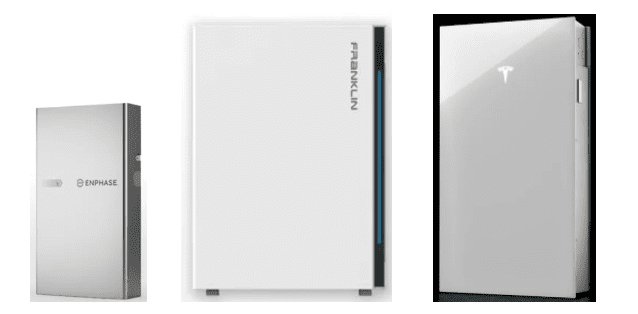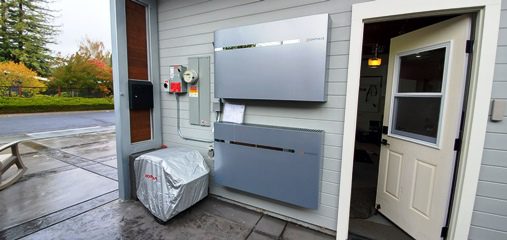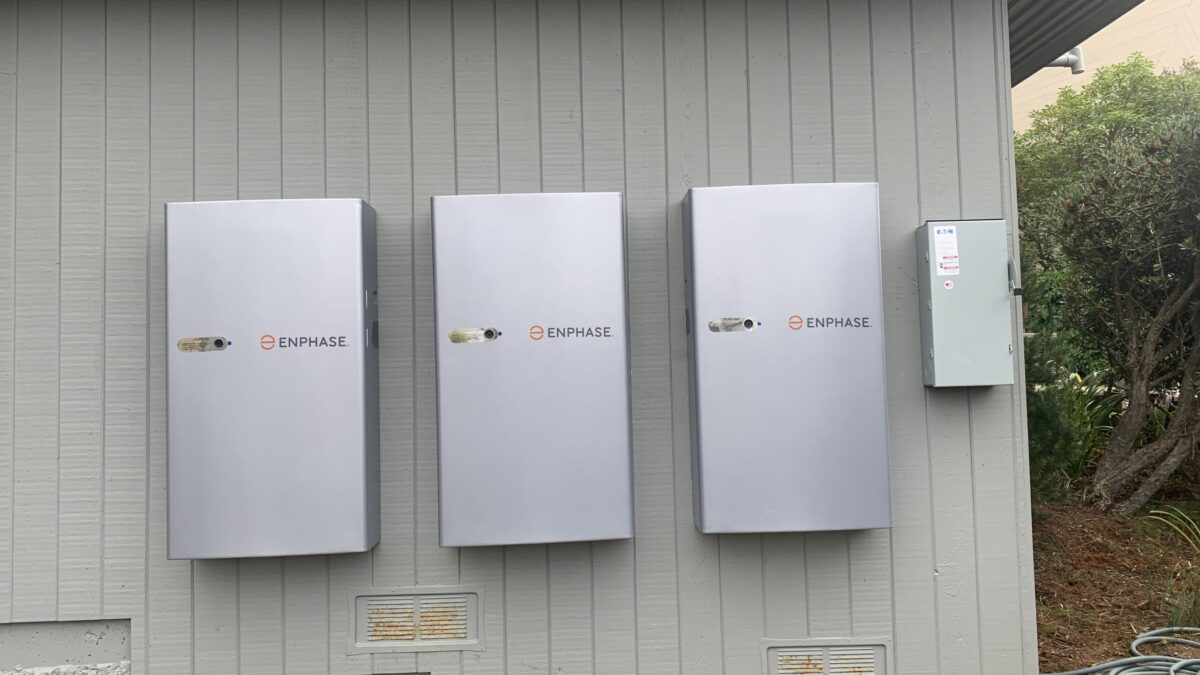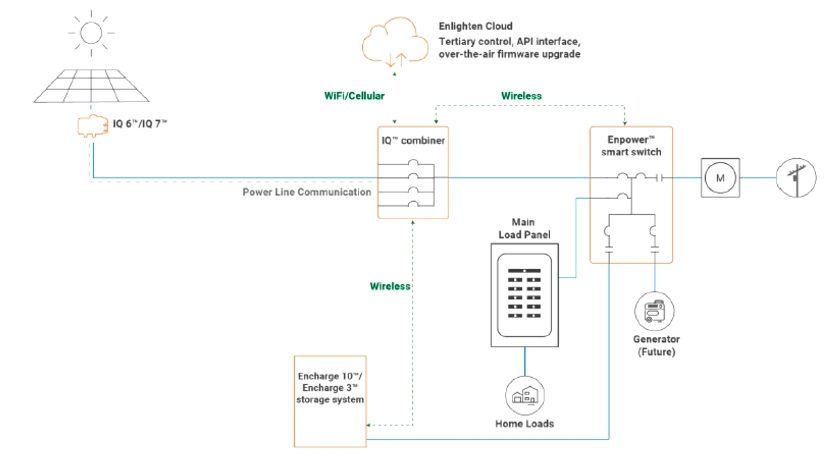Backup Power Options to Prepare for the Next Power Outage
The two common solutions to provide power during a power outage are Battery backup systems and Generators. Both have their advantages and disadvantages.

The ultimate solution is a battery backup system with a whole-home generator. But first some general information…
Solar and Anti-Islanding
If you have a solar system that is connected to the grid (grid tied), by code it is required to have a feature called “anti-islanding”. The inverters in your solar system are always monitoring the power from the grid to be within a certain voltage and frequency range. If the grid goes out of this range (including shuts down), then the inverters automatically shut down to prevent exporting power which can cause brown outs and create safety issues for utility repair persons. Thus, your typical solar system does not work during a power outage.
Energy Storage Systems
Battery systems are Energy Storage Systems (ESS). ESS coupled to solar can be used to store solar power generated during the day and discharge after solar hours, typically from 4-9 PM (peak hours). This is a common use for Net Energy Metering (NEM). Under NEM 1 & NEM 2, some savings can be realized by offsetting peak rates. Under NEM 3 (Also known as Net Billing Tarriff or NBT), this is a critical feature of any solar system.
Solar and ESS is standard to maximize savings under NBT. Solar and ESS do not require a transfer switch to offset usage during non-solar hours. However, they will not operate during a power outage unless the transfer switch is included.
Transfer Switch
In order for any system to provide power to your home through your homes electrical system requires the use of a transfer switch. This physically disconnects your electrical system at the transfer switches point of connection from PG&E and enables you to provide power from an alternate source like battery back-up or a generator. These can be manual or automatic. Most battery backup systems and home generators use an automatic transfer switch that is designed to work with their product. Generator transfer switches generally take about 15 seconds to transfer power while battery transfer switches can transfer in fractions of a second. NONE OF THE SYSTEMS BELOW SHOULD BE CONSIDERED FOR POWERING CRITICAL MEDICAL DEVICES WITHOUT ADDITIONAL EQUIPMENT (Not discussed here).
Adding a transfer switch to an existing solar system will not enable the solar to work unless there is a battery backup system. The exception to this is the Enphase IQ8 series based solar system when coupled with a transfer switch. The Enphase IQ8 system is capable of providing limited power when the solar is producing during a power outage. This is known as sunlight backup.
Battery Backup
There are many manufacturers of ESS that are capable of providing backup power when the grid is down. Today there are many very good solutions that are available and many manufacturers are already on their second or third generation systems. There is also extensive research and investment being poured into the next generation battery technologies. It’s very possible that in the next 5 years or so, we could see battery technologies emerge that are significantly better than today’s solutions.
Lithium-Ion batteries are the most common batteries used in Home ESS’s. There are two major chemistries used in these batteries: Nickle Manganese Cobalt (NMC) and Iron or Ferro Phosphate (LFP). NMC batteries are common in Electric Vehicles due to their high energy density to weight ratios. However, NMC batteries can suffer from thermal runaway- a situation where the failure of one cell in the pack can cause a cascading failure in the battery pack. There are many safety measures to prevent thermal runaway, so the odds of this occurring are very low, but the result can be catastrophic.
Unlike NMC, LFP batteries can cycle from 5-100% charge levels with minimal impact on service life. LFP systems are also more environmentally friendly than NMC systems as no Cobalt is used. More manufacturers are now using LFP batteries given their many advantages over NMC batteries when used as an ESS.
For additional information, see our energy storage systems page
Energy Storage Systems: Two Factors to Consider
There are two major factors to consider when selecting an ESS for backup: Peak power output and Energy stored. The peak power determines how much power the system can support. Most solutions run between 5 kW and 10 kW of power or approximately 20 amps to 40 amps at 240VAC. Newer systems are also capable of providing significantly more power. Systems can provide higher peak outputs for short periods of times (generally less than 10 seconds) to help start items with high initial start-up loads like AC units or well pumps. This varies significantly among the various ESS manufacturers.
The energy storage of most standard or common sized systems runs between 10 and 15 kWhrs. ESS systems under 15 kWhrs are generally acceptable for partial-home backup while systems over 20 kWhrs can be suitable for whole-home backup. If your home is using 1kW of power and has a fully charged 10kWhr (usable) battery, the system can provide power for 10 hours before it needs to be recharged. This is generally enough to support a refrigerator, some LED lighting, charge phones and computers during the night. Use of high demand appliance like air conditioning can use up the battery in less than a few hours. If you also plan to use your battery to offset usage (peak rates, NBT), its best to increase capacity so reserve is available for power outages.
When paired with a solar system, the ESS can be recharged during the day. The rate at which the battery can be recharged depends on the home loads during the day and the size of the solar system. If power goes out during a rainy day, late in the year with less solar access, or a smokey day, the solar system’s ability to recharge the battery will be greatly diminished. Some ESS’s have inputs for generators as a backup means to charge the battery when solar is not sufficient.
Generators
Effective Jan 1st 2028, portable gasoline generators will no longer be sold in CA per AB 1346. Existing generators can still be used. This does not impact propane, natural gas or diesel generators.
The main advantage of generators relative to battery backup, is that generators can provide more power, can cost less, and are not impacted by weather. The main disadvantages are that they don’t enable your solar system to operate, are loud and require fuel & maintenance.
Water cooled generators are a lot quieter than air cooled generators, but installed costs are almost 2X. They are also much more durable. The quietest generators are the small portable Honda generators.
Generators Require Fuel to Operate
Generators can run on natural gas, propane, gasoline, and diesel. Most home backup generators are designed to run on natural gas or propane and are permanently connected to these sources. Most portable generators run on gasoline, but some have options to run on gasoline and natural gas and/or propane. Note that while up-front costs for generators are low compared to battery backup, the operating costs can add up fast. Fuel isn’t cheap, especially when you are using it 24 hrs/day for several days in a row. Access to fuel can also be an issue: Gas stations run out of gasoline and diesel during prolonged outages. Natural gas supply can be cut off as a safety measure as has happened in several cities during planned shut downs. Natural gas lines can also be disrupted in a major disaster like an earthquake. Propane is good, but eventually your tank will need to be refilled and there is no guarantee your supplier will be able to do so during a disaster. The size of your generator will also have a big impact on your fuel usage. A 12 kW generator at low load uses a lot less fuel than a 24 kW generator at low load, and most of the time your generator will be running at low load. Sizing for extra capacity will cost you more in operating costs.
Generator Quality
The quality of your generator also generally determines the quality of the power output. $1,000 generators from the big box stores tend to produce fairly “dirty” power. The output is not the same as from the utilities. The better the generator, the better the power matches the output from the utility. If you have sensitive electronics, pay attention to the power output. Look for low THD (total harmonic distortion), pure sine wave or inverter based generators. If you have solar and you later add a home generator, make sure the system is designed so the solar does not turn during a power outage as it can damage the generator and/or the solar system.
If you have a portable generator NEVER EVER OPERATE IT INDOORS OR IN A GARAGE. MAKE SURE THE EXHAUST CAN NOT GET IN A WINDOW OR DOOR. Carbon Monoxide is an odorless gas that can kill you without warning!!! If you see someone doing this, alert them to the dangers of doing so immediately. There are lots of people who run out and buy generators with each planned power shut down that are not aware of these dangers.
There are also portable battery generators. These are “generators” that use batteries for power. They can also come with small portable solar arrays to charge the batteries. These generally don’t produce much more than 1,000 watts and are pricey compared to portable generators, but they are quiet and don’t require fuel. Two good companies for this are Goal Zero and Simplifi. Both can be found on Amazon.
What Now?
There are clearly lots of choices and no one size fits all approach. If you are looking for the least expensive solution to provide power for the basics (a refrigerator, some lights, charge phones/computers) we recommend getting a small Honda portable generator and some extension cords. This is a very quiet and cost effective solution. Just do it well before you need it, so you are not racing to the store to get the last remaining generator.
If you are interested in getting a quote for a battery backup system and or a home generator, give us a call so we can determine the best solution for you. We install solar systems, battery backup systems and home generators.


 Solar Company
Solar Company 




